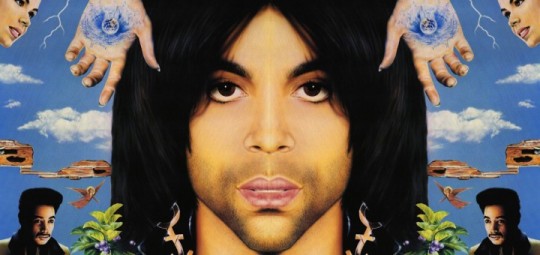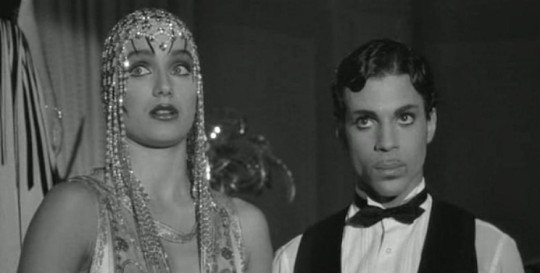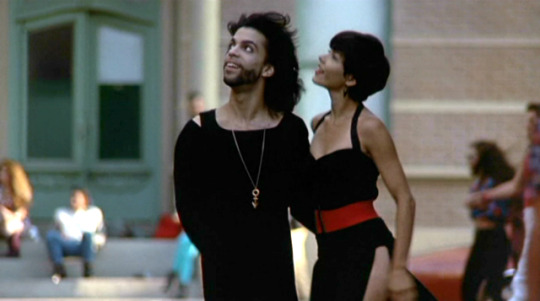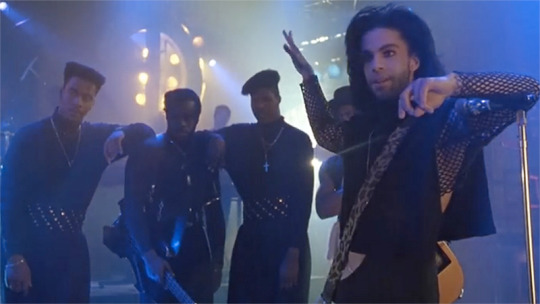The Unlikely Autobiography of Princes Under the Cherry Moon and Graffiti Bridgeby Jake Cole
By Yasmina Tawil

Prince’s cinematic legacy effectively starts and stops with Purple Rain, the 1984 smash that cast the artist in a Star Is Born narrative. In the face of the overwhelming apocrypha surrounding the Prince, the film also doubled as mythic origin story by offering a plausible autobiography. Yet despite the enduring entertainment value of the film, it arguably loses something of Prince’s essence in smoothing out his kinks. “I’m not a woman/I’m not a man/I am something that you’ll never understand,” he sings on “I Would Die 4 U,” but this Prince is, apart from his aloof demeanor and strange outfits, entirely legible.
To get a cinematic sense of the true Prince, in all his baffling, maddening contradiction, one must turn to his own directorial efforts: 1986’s Under the Cherry Moon and 1990’s Graffiti Bridge. Released to widespread derision, the films today enjoy trashy reputations that they come by honestly. Nonetheless, each provides a glimpse into the unfettered creative mind of Prince as it struggles to grasp a format foreign to him. The results are undeniably baffling and scattered, but in their contradictions lie an unpolished, unprotected view of Prince’s personality, artistic worldview, and his well-cloaked self-awareness.
None of this is readily visible on the surface of either film, both of which center their plots on how much Prince’s characters get laid. In Under the Cherry Moon, he plays Christopher Tracy, a gigolo who, along with his brother, Tricky (Jerome Benton), beds and bilks rich women across the French Riviera. Eventually, he targets loaded heiress Mary Sharon (Kristin Scott Thomas), only to fall in love. Graffiti Bridge takes this split between love and sex even further: In this loose Purple Rain sequel, the Kid (Prince) actively vies with The Time’s Morris (Morris Day) for the affections of Aura (Ingrid Chavez). This is just a replay of the two figures’ war for Apollonia’s hand in Purple Rain, but the twist here is that the Madonna/whore complex that frequently informs Prince’s view of romance is literalized by Aura’s ethereal nature. In effect, both the Kid and Morris spend the entire movie attempting to screw an angel.

Prince’s libidinous forays bring out the rakish troublemaker in him, and the wry sense of irony he displayed in Purple Rain blossoms into a peevish sense of humor. Christopher Tracy delights in messing with Mary, responding to her ability to see through his empty charms by simply doubling down on them. Surrounded by stuck-up elites, Christopher is unabashedly common, and Prince emphasizes his inappropriate outbursts and leers to shake Mary out of her aloofness. In Graffiti Bridge, the Kid is back to his arch ways, but the film itself bursts with a free-spirited comedy. Cartoon sound effects, exaggerated camera movements, and the catty chemistry between Prince and Morris all contribute to a goofiness that shows the artist cutting loose from his solemn, stern image.
The seemingly random stylistic clashes of both films likewise reveal the artist from a new angle. Cherry Moon’s velvety, black-and-white cinematography (courtesy of Rainer Werner Fassbinder/Martin Scorsese mainstay Michael Ballhaus) provides a grounding element for the manic intensity of the film’s tone, but the professionalism of the images matches a curious aspect of the movie. Released at the peak of Prince’s working relationship with Warner Bros, the film looks like a rapid sprint through much of that company’s studio history. The smoky nightclubs where Christopher searches for new marks vaguely recalls the setting of Casablanca; Prince and Jerome’s teasing interplay updates Abbott and Costello; and the antic, raunchy, gold-digger comedy harks back to the Pre-Code era.
For its part, Graffiti Bridge pulls from a long history of backlot musicals, replacing the semi-realism of Purple Rain’s Minneapolis setting for a highly chromatic, hyperreal image of a city that appears to consist of nothing but nightclubs. But if the art direction of the previous film offered a playground for Prince’s melodramatic comedy, the set design of this rotting pleasure city illustrates a societal moral failure that contrasts with the artist’s spiritual enlightenment, which is cued by the Kid’s wardrobe as much as his speech. Dressed in flowing tunics and sporting long, straightened locks and a beard that looks drawn in mascara instead of grown, the Kid resembles an icon of Jesus as painted by a particularly thirsty worshipper. Prince had never shied away from airing his religious beliefs, but here he transforms the Kid from an aspiring rock star to someone who would rather spread “that spiritual noise,” as Morris terms it, than get a platinum record.

This moral conflict places particular emphasis on the film’s music, and both Graffiti Bridge and Under the Cherry Moon make as much thematic and narrative use of music as Purple Rain. Cherry Moon, which only occasionally uses the soundtrack diegetically, employs its songs more as mood music than plot device, but they nonetheless flesh out the strange energy of the picture. The introductory shots of Nice are set to the synthesized pan flutes and gated marching snares that open “Christopher Tracy’s Parade,” a disorienting track that fits well within the rapid montage. “New Position” scores an on-screen conga with its driving steel drum, though the flagrant sexuality of its lyrics clashes wildly with images of upper-class party guests in tuxedos and gowns shuffling around a gazebo. Short, jazzy ballads fill time, and one song, “Life Can Be So Nice,” manages to make a dance track principally driven by calliope trills. Prince composes pop in an exoticized, exaggerated European manner, synchronizing with the film’s tacky glitz and eclectic assembly.
The soundtrack is most important for its status as the final album released with the Revolution, though you’d be forgiven for assuming they were already out the door based on the music. By this point, the band had bloated in size, adding new musicians as well as backup dancers whose presence chafed on the core group, but everyone takes a backseat to Clare Fischer’s orchestral arrangements and Prince’s own fussy and brittle compositions. As much as the film around it, the soundtrack is an experiment, and it pinpoints an artist who had grown bored of the format he was playing and wished to follow new paths, regardless of how it affected his collaborators.
The opening of Graffiti Bridge encapsulates that turn back toward Prince’s one-man-band tendencies, finding the Kid sitting at a synthesizer keyboard hooked up to a computer that instantly transcribes and sequences whatever he plays. Purple Rain showed the Kid amid an array of instruments, but now he can lay down entire songs sitting at a desk, technology having finally caught up to his ambition. The artist looks so comfortable with this lonely setup, so empowered by software that can faithfully produce his music according to his sole input, that the film never generates a believable conflict around his musical drive.

Despite this vision of Prince as the Howard Hughes of songwriters, Graffiti Bridge sets itself apart from its predecessor, as well as Purple Rain, in how enthusiastically it embraces a collective musical dynamic. The Kid is, of course, front and center, but he nonetheless appears in nearly all public spaces flanked by his recently formed backing group the New Power Generation, who replace the stark artpop of the previous film with all-hands-on-deck funk. Purple Rain involved the Revolution, albeit mostly as an endpoint for the Kid, who had to reconcile his egotism with the fruitfulness of collaboration. No such conflict exists here, and in fact Prince sounds rejuvenated with this new group, who issue a bracing mission statement in their first appearance: “We are the new power generation, we want to change the world/The only thing that’s in our way is you/Your old fashioned music, your old ideas/We’re sick and tired of you telling us what to do.”
The forceful energy of such declarations and the intricate arrangements of the songs emphasizes the film’s free-form aesthetic, and the inevitability of Prince’s will asserting itself prefigures the narrative’s collapse into self-importance. If the New Power Generation escape the kind of torment heaped upon the Revolution in Purple Rain, they pay for their leader’s affability with a blind loyalty that the previous band never showed. Befitting the film’s spiritual angle, Prince’s relationship with the band is less monarch-subject than prophet-acolyte, with the NPG not so much sharing a unified vision as fulfilling one passed down from on high. That religiosity informs much of the music, be it the chorus of “Elephants & Flowers” declaring “There will be peace for those who love god a lot,” or “Thieves in the Temple” casting the Kid’s sense of betrayal at Aura’s interest in Morris in Biblical terms.
Of course, the most immediately striking difference between the New Power Generation and the Revolution is that the former replaced the latter’s multiracial makeup with an all-black group. Race occupied a peripheral role in Prince’s early career, and the artist obfuscated what little he addressed. Purple Rain, for example, set down as tacit canon his fib that he was biracial by casting white actress Olga Karlatos as the Kid’s mother. Prince’s early caginess on the subject of race is understandable: as someone who fused various dichotomies into an androgynous, heterogeneous style, to claim black and white heritage merely confirmed him as the peak of musical fusion, a man whose gifts for wedding disparate sounds transcended form and applied to his very genes. He also had to deal with the pressures of being a crossover musician at the dawn of MTV, “crossover” being a euphemistic term for a black artist who appealed to white audiences.
Graffiti Bridge is the endpoint of a decade that Prince spent chasing after and maintaining pop success, of relegating the avant-funk that defined records like Dirty Mind and 1999 to B-sides, of shelving an entire LP pointedly titled The Black Album because he felt ominous misgivings about releasing it. The music of the film is informed by the increasing sophistication of Prince’s arrangements and songwriting, but it’s also bolstered by the return of a full-band dynamic, which fleshes out the art-funk of Sign ‘O’ the Times into party music. Though most of the music came out of sessions recorded four years earlier, the big-band versions used for the soundtrack have a looseness not regularly glimpsed in Prince’s work since 1985.
That looseness epitomizes the tone of the film, which may indulge Prince too freely but does show a famously reclusive artist having unabashed fun. Where Prince’s previous two films stressed the extent to which he set his own style, Graffiti Bridge shows Prince clearly taking from prevailing trends in black culture, from fashion fads of flat-top haircuts and military jackets to the soundtrack heavy with the heavily syncopated, house- and hip-hop-inspired breaks of New Jack Swing. Prince at last engages with pop culture of the present, including critiquing the elements he finds distasteful. The Time, as in Purple Rain, plays lyrically vulgar and entertaining but ultimately derivative music, but here they stand in for the self-defeating superficiality Prince saw in emerging genres. He pits The Time against the Kid’s reconciliation of that style with a higher calling, balancing the sacred and profane. More than any of Prince’s other features, Graffiti Bridge is not merely a vehicle for his music but a direct narrative about it, culminating in his ecstatic realization that his quest to reconcile his lust and devotion are not an aberration but the logical continuation that stretched back to Ray Charles’s secularized gospel.

To get a better sense of the tension released in Graffiti Bridge, one needs only to return to Under the Cherry Moon. If the film offers a loving sprint through various WB studio staples, it also presents, hidden in plain sight, a metaphor for Prince navigating a vast studio legacy and power structure. Not only does the script flip gender roles in its screwball comedy, it also presents its hero and his brother as the only two black men in a sea of white faces, two-timing enterprisers who have to hustle every buck from a pool of inherited wealth. Christopher Tracy sticks out like a sore thumb, but despite Prince’s bawdy performance, with its tacky disruptions, it’s clear that he does want to fit into this milieu.
Much of the film’s humor stems from this fractious intersection of race. The stilted line deliveries of the white actors can be understood not only as an indictment of the unwieldy dialogue of Prince’s screenwriting but his mockery of “normal” white voice. Everyone sounds like a black comedian’s impression of a white person, in which a total lack of rhythm infects everyday speech. No one pulls this off as well as Steven Berkoff, who plays Mary’s caricatural father, Isaac, and gives the impression of bypassing his mouth entirely when speaking, instead sending words hurtling out of his right nostril in pinched tones. Christopher’s antic relationship to the people around him only reinforces that he does not belong, and the famed Wrecka Stow scene—an extended, phonetic-based shaggy dog joke that Christopher and Tricky play on Mary—is one of the few times that he feels truly comfortable being himself as something beyond a purely sexual agent.
But there’s a serious side to this subtle satire, and it occasionally peeks out of the film’s glinting edges. Prince, one of the best pop dancers of the 20th century, includes a scene where Christopher does a brief ballroom dance with Mary but moves with surprising stiffness, his legs jerking confusedly to the slowed tempos and classical instrumentation to which he and Mary are moving. Compare this to the scene in which Christopher plays “Girls & Boys” on a boombox and leaps on top of a piano to dance. In that moment, he moves with all his natural litheness, in his element instead of tamping down his natural desire to groove.
That struggle to assimilate plays out in the music, by far the most airless and buttoned-up in his immense discography; a Graffiti Bridge ballad like “The Question of U” can make space for a lurching bassline, while this film’s funkiest track, “Kiss,” doesn’t have a bass guitar at all. Nothing, though, is as bracingly forthright about this theme as the finale, in which Isaac, enraged that his daughter would debase herself with the likes of Christopher, has an underling shoot the man in the back right in front of her. For Prince, then at the height of his popularity, to write a story that ends with him murdered for miscegenation is profoundly startling, an acknowledgment that despite being on top of the world, such an event is not remotely outside the bounds of plausibility.
More than anything in Prince’s slim filmography, the conclusion of Under the Cherry Moon provides a lens through which to view him. The common line on Prince is that he is an alienating figure, that his detached weirdness, unfathomable genius, and diva behavior separate him from any sense of normalcy. But Under the Cherry Moon, as well as Graffiti Bridge, suggests that the inverse is also true, that Prince was at the very least aware enough to feel alienated himself. The two films complete a loose thematic trilogy that begins with an artist finding success, then discovering the limits of that inclusion. Finally, he finds his true personal and musical self in the rejection of that compromised value system and the adoption of a style he would maintain for much of the rest of his life. At the time of Prince’s death, it was revealed that he had just started work on a memoir. With that book now permanently left unwritten, these films now stand as the best available means of getting an account of the artist’s life in his own terms.


